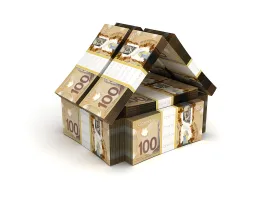This Ontario couple's $650,000 rental property is key to rationalizing their retirement finances
With debt management and enhanced returns on their assets, they can make it, expert says

Expert says Christopher and Melissa's rental property is key to rationalizing their retirement finances.
In Ontario, a couple we’ll call Christopher, 43, and Melissa, 47, are raising their three-year-old child Noah. They bring home $9,000 per month after tax from their jobs in financial services and non-profit administration, respectively. Their balance sheet has an $800,000 home, a $650,000 rental, $1,997 in TFSAs, $122,450 in RRSPs, $33,138 in Noah’s RESP, and a $20,000 car. That’s $1,215,585.
Take off mortgages of $261,000 for their home, $12,000 due on credit cards and $139,000 for the rental and they have a net worth of $1,215,585.
Christopher and Melissa want to swap their 9 to 5 jobs, move to the country and build a modest home on an acre of land — they think it would cost $100,000 — then retire on what they hope would be $50,000 income before tax each year. Their question — can they do it?
Family Finance asked Derek Moran, head of Smarter Financial Planning Ltd. of Kelowna, B.C., to work with Christopher and Melissa. His view – with debt management and enhanced returns on their assets, they can make it.
Debt and investments
First move — use a Home Equity Line of Credit, a HELOC, to reduce interest on $12,000 in outstanding credit card loans they have used for home renovations. They pay $1,000 per month on their credit cards at about 19 per cent interest. The HELOC, which is essentially a non-amortizing mortgage add-on, would cost them four per cent to six per cent per year with present interest rates.
The efficiency of their investments also needs to be examined. The $650,000 rental has a $139,000 mortgage and thus leaves them with $511,000 equity. It generates gross rent of $18,000 per year. Take off $1,491 property tax, $2,780 interest only on their mortgage, $6,240 condo fees, and $791 annual costs for accounting and bank fees and they are left with $6,698 net income. That’s a 1.3 per cent return for a lot of risk and nuisance. They paid $178,000 for it in 2009.
If they sell, the gain in value would be $650,000 less $178,000 or $472,000. They would also incur $35,000 selling costs, for a net gain of $178,000. They have owned it for 14 years during which they lived in it for two years, so 21 per cent (two plus a free year equals three divided by 14) or $91,770 would be tax-free.
Half of the remaining $345,230 capital gain would be taxable ($172,615), but if they use some of the proceeds to max out their RRSP contribution room of $138,957 they would only pay tax on $67,316. At an average tax rate 20 per cent, the tax bill would be just $13,463.
After paying off the mortgage and the selling costs, the proceeds of the sale would be $476,000. Subtract the tax bill and the amount dedicated to their RRSPs and they would have an additional $323,580 — more than enough to acquire a piece of land for retirement.
Noah’s RESP has $33,138. They add $110 per month and the Canada Education Savings Grant of the lesser of 20 per cent of contributions or $500 per year makes total additions $1,584 per year. They can continue to add to the account until the CESG, which has a $7,200 cap per beneficiary, is exhausted, Moran suggests. When Noah gets a proof of acceptance at a post-secondary institution, he can tap its $70,000 estimated value at age 17 for many expenses such as tuition or living costs.
Retirement expenses and income
When Christopher and Melissa retire, their expenses will be considerably lower than the $9,000 they are currently allocating per month. Without mortgage costs, expenses related to the condo, which they are selling, and no need to save, they will only need about $4,000 per month or $48,000 per year to get by.
The couple will be able to rely on Christopher’s $4,126 monthly defined benefit pension, estimated CPP for Christopher at 80 per cent of the present maximum $15,043 per year and 90 per cent for Melissa. That’s $12,034 per year for Christopher and $13,539 for Melissa.
Their RRSPs currently total $122,450, but if they add funds from the sale of the rental and continue to add $4,800 per year and the combined plans grow at three per cent over the rate of inflation, they should have a balance of $442,869 in 12 years when they plan to retire at Melissa’s age 59.
If they use most of the remaining funds from the sale of the rental to pay down their home mortgage as well, they could leave themselves with just $40,000 in mortgage debt, which they can pay off in 40 months rather than 19 years on the present schedule, Moran estimates. They will thus free up $1,400 per month for nine more years, and if invested at three per cent after inflation they would have $175,793 additional capital at retirement. If we put all of that together, they would have $618,662 RRSP savings in 12 years. That money would generate $30,030 for the following 31 years to Melissa’s age 90. Any carryover interest resulting from interest rates rising in the next dozen years can go to their parched TFSAs with present combined balances of $1,997.
Retirement income predictions
With these investment adjustments, the couple will have three financially distinct periods for retirement: first, from retirement when Melissa is 59 to her age 65, second at her age 65 with CPP and OAS and third at the time Christopher is 65 and is receiving his CPP and OAS.
Using this time schedule, in stage one their retirement incomes would be $49,512 from Christopher’s pension, and RRSP benefits of $30,030 for total retirement income $79,542. With splits of eligible income and 13 per cent average tax, they would have $69,200 per year or $5,768 per month. That would more than cover monthly core expenses, as explained.
In stage two, they could add Melissa’s $13,539 CPP and her $8,004 OAS for total income of $101,085. After 14 per cent average tax, they would have $86,933 per year or $7,244 per month to spend.
In stage three, with Christopher’s $8,004 OAS and his $15,043 CPP, total income would rise to $124,132. After splits of eligible income and 16 per cent average tax, they would have $104,270 to spend per year or $8,690 per month. If inflation rates rise, indexed pensions such as OAS and CPP will compensate and investment returns such as corporate dividends may grow.
Retirement stars: 3 ***out of 5
Financial Post
( C) 2022 The Financial Post, Used by Permission

































